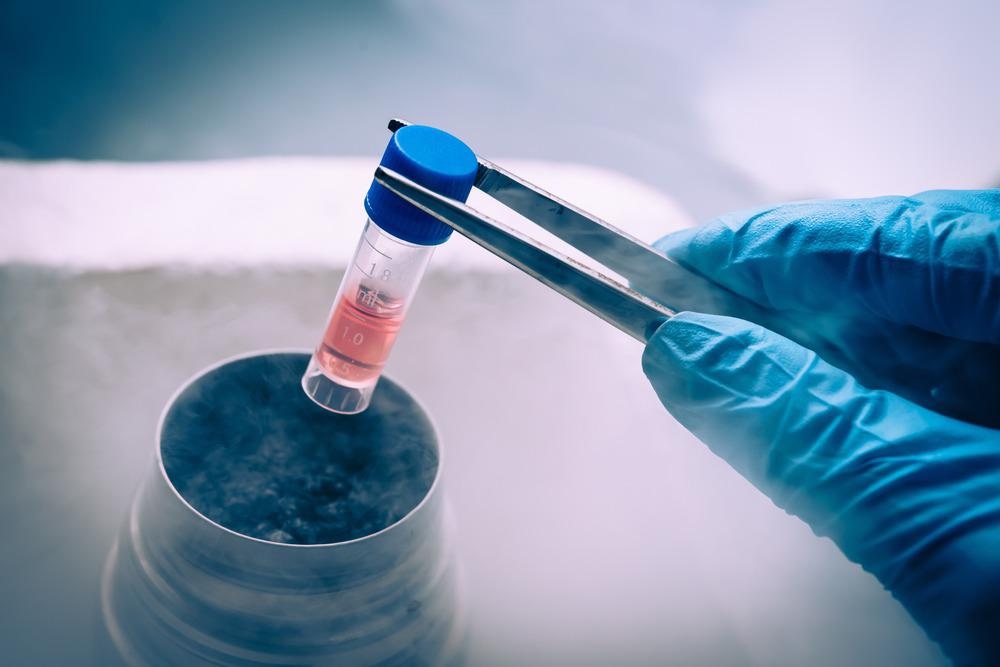Like any other cellular therapy, stem cells must be stored at appropriate temperatures and conditions to conserve their specific cellular attributes. To date, the United States Food and Drug Administration (FDA) has estimated that about 80% of human mesenchymal stem cells (MSCs) are cryopreserved during their manufacturing process.

Image Credit: Elena Pavlovich/Shutterstock.com
Cryopreservation and Cells
By definition, cryopreservation refers to the utilization of extremely low temperatures to preserve the structural and functional integrity of cells and tissues as they transition from the aqueous phase to the solid phase. Once frozen, cryopreserved cells and tissues can remain stable, particularly when kept either at -80 °C or in liquid nitrogen at a temperature of -196 °C.
One of the key advantages associated with the cryopreservation of cells, particularly stem cells, is that it prevents the need to maintain cells in culture for extended periods of time, leading to epigenetic changes and genetic drifts. Furthermore, cryopreserving cells can ensure the maintenance of desired cell phenotypes while also extending their shelf life.
In terms of its therapeutic advantages, cryopreserving cells allows multiple treatments to be applied to the same batch of cells, thereby providing a flexible treatment schedule for patients.
How Temperature Affects Stem Cells
Adult stem cells are the longest living proliferative cells that exist in multicellular organisms. Regardless of whether these cells reside within an organism or in culture, stem cells are associated with an intrinsically increased risk of accumulating metabolic and genetic damage that can ultimately prevent their ability to multiply. Notably, several environmental factors, including exposure to toxins or harsh temperatures, can accumulate such damage.
Each subtype of stem cell is associated with its own distinct properties that determine its resistance to certain changes in temperature. For example, adipose-derived stem cells (ADSCs) retain their proliferation and differentiation capacities when cryopreserved for extended periods of time. However, it is crucial that an appropriate protection medium like dimethyl sulfoxide (DMSO) is incorporated into the frozen ADSC vial to prevent irreversible damage to the ADSC membrane.
Aside from cryopreservation, maintaining stem cells within a specified temperature range is essential for their growth in culture. Like many other types of cells that are grown in culture, stem cells must be maintained in an incubator at 37 °C and with a carbon dioxide (CO2) concentration of 5%.
In a recent study, researchers investigated the viability of human MSCs after being incubated at temperatures of 38 °C, 48 °C, and 58 °C for 45 seconds, 80 seconds, and 150 seconds. Herein, the researchers found that irreversible damage to cell integrity occurs to MSCs when exposed to 58 °C for only 45 seconds; however, cell metabolism was not significantly altered when the cells were exposed to 48 °C for 150 seconds.
Temperature Sensors for Stem Cells
Several different types of sensors have been used to monitor the temperature of cells for biological research purposes. These sensors include calorimeters like differential scanning calorimeters (DSCs), isothermal microcalorimeters (IMC), luminescent temperature sensors, and cantilever sensors.
Despite the availability of these types of sensors, it remains a challenge to monitor the temperature of macroscopic objects like cells due to their small size.
In an effort to overcome these challenges, several novel thermal sensors have been developed. Fluorescent nanothermometers, in particular, have gained the interest of researchers looking to monitor the temperature within microscopic reactors, cells, and living organisms.
To date, three different mechanisms have been incorporated into these nanothermometers, including emission intensity, ratiometric fluorescence, and changes in lifetime. Importantly, each of these approaches are associated with their own distinct advantages and disadvantages, some of which include photobleaching, sensitivity to pH, ionic strength, and concentration dependence.
Moreover, one recent study discusses boron dipyrromethene (BODIPY) molecular rotors that are modified with a polyethylene glycol (PEG) chain to sense temperatures and simultaneously provide live cell imaging. This probe was found to provide reproducible measurements upon heating and cooling cell samples without causing significant variations to arise in the pH or ionic strength of the sample.
Conclusion
Temperature plays a crucial role in the ability of stem cells to be grown in vitro and stored for extended periods of time. Various types of sensors are currently available to ensure precise temperatures are maintained for both cryopreservation and culturing of stem cells.
Continue reading: Bio-Sensing Dipstick Test for E. Coli in Water.
References and Further Reading
Reissis, Y., Garcia-Gareta, E., Korda, M., et al. (2013). The effect of temperature on the viability of human mesenchymal stem cells. Stem Cell Research & Therapy 4(6); 139. Available at: www.ncbi.nlm.nih.gov/pmc/articles/PMC4055049/
Hunt, C. J. (2019). Temperature Storage and Thawing of Stem Cells for Cellular Therapies. Transfusion Medicine and Hemotherapy 46; 134-149. Available at: www.karger.com/Article/Fulltext/497289
Shimoni, C., Goldstein, M., Ribarski-Chorev, I., et al (2020). Heat Shock Alters Mesenchymal Stem Cell Identity and Induces Premature Senescence. Frontiers in Cell and Developmental Biology. Available at: www.frontiersin.org/articles/10.3389/fcell.2020.565970/full
Wu, Y., Li, M., Liao, X., et al (2019). Effects of storage culture media, temperature and duration on human adipose-derived stem cell viability for clinical use. Molecular Medicine Reports. Available at: www.spandidos-publications.com/10.3892/mmr.2019.9842
Ogle, M. M., McWilliams, A. D. S., Ware, M. J., et al (2019). Sensing Temperature In Vitro and in Cells Using a BODIPY Molecular Probe. The Journal of Physical Chemistry 8(123); 7282-7289. Available at: pubs.acs.org/doi/pdf/10.1021/acs.jpcb.9b04384
Disclaimer: The views expressed here are those of the author expressed in their private capacity and do not necessarily represent the views of AZoM.com Limited T/A AZoNetwork the owner and operator of this website. This disclaimer forms part of the Terms and conditions of use of this website.